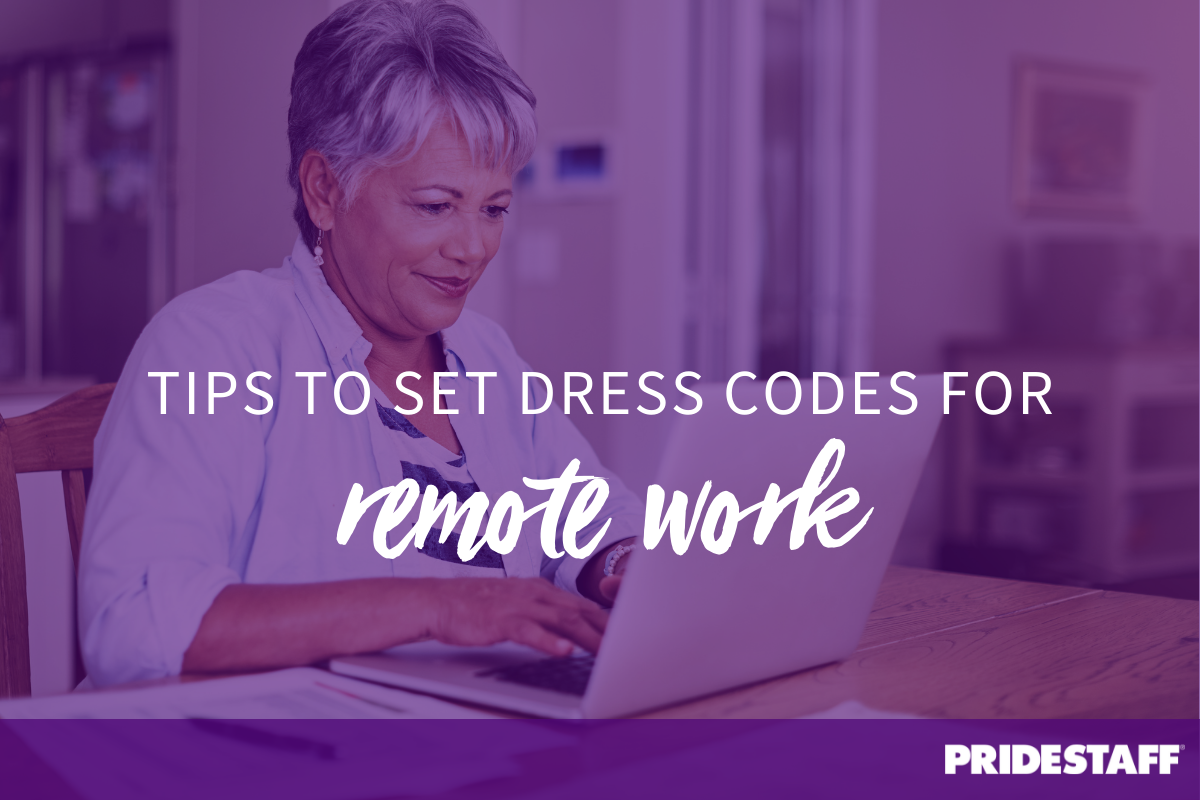How to Set & Standardize Dress Codes in a Remote Work Environment

Business on top, party on the bottom!
Cases of the jokingly, albeit accurately, dubbed “business mullet” are appearing all over the internet as more people now work from home.
And while we can’t exactly comment on the practicality of the business mullet, there’s one thing we can say for sure – remote work is here to stay.
Establishing a dress code might seem the least of your worries when managing a team that works from home, but standardizing remote employee attire is more important than you might think.
Why Is Remote Employee Attire Important?
A recent survey conducted by the Society for Human Resource Management revealed that 60% of surveyed Americans wear athletic or casual wear – think sweatpants and hoodies – while working from home. Still 34% of those surveyed remain in that attire for video calls.
We don’t need to say it, but employees showing up to meetings in clothing that’s one step away from pajamas shouldn’t become the norm. What your employees wear is a direct representation of your company and your values.
Professionalism aside, there are plenty of other benefits to creating and maintaining a remote work dress code.
Maintaining a Remote Dress Code for Employees Promotes Productivity
Cozy sweats, a snuggly sweater and slippers – the more comfortable you are, the easier it will be to get through your to-do list, right? Maybe not.
Studies show formal dressers report feeling more productive while working from home. Those regularly dressed in casual wear and pajamas, interestingly enough, don’t share the same thoughts.
Sharing these statistics with your team and encouraging a remote dress code can incentivize productivity. The faster your employees finish their day, the quicker they can change into their favorite hoodie.
Working from home can make it challenging to create a work-life balance – this is an easy way to create the separation many remote employees seek.
Standardizing Work-from-Home Wear Creates a Feeling of Togetherness
Remote employees may struggle to feel they’re really part of a team.
A work-from-home dress code ensures that, no matter where employees are in the world, at least they’re dressed the same!
An employee who logs on to a meeting to see their coworkers in similar attire is more likely to feel connected and welcomed by their team – and therefore more motivated and ready to work.
A Remote Dress Code Can Boost Morale
This one may feel counterintuitive, so stay with us here.
Casual, “dress down” days can boost employee morale – but these days lose their shine for remote employees who regularly work in their pajamas.
Maintaining a remote dress code adds more value to days where employees are encouraged to wear their favorite sweats.
Creating a Dress Code for Remote Employees
Creating a dress code – much less a remote dress code – may be a daunting task, but it doesn’t have to be difficult.
Determining why your company has attire requirements is an important first consideration in creating these guidelines.
Why do you have a work-from-home dress code?
Dress codes exist for a number of reasons – are you looking to create uniformity in your team? Promote a specific company image?
If you’re seeking to create a professional, conservative business environment, for example, it may make sense that your dress code does not allow for cargo shorts or tube tops.
On the other hand, a company seeking a more relaxed feel may be fine with open-toed shoes or flip flops, especially in the warmer months.
Be specific in your guidelines.
Business formal, casual, black tie – buzzwords like these bounce around wardrobe guidelines, ultimately making for dress codes that read well but enforce nothing.
If you’re going to use overarching terms in your work-from-home dress code, avoid confusion by defining what you want.
“Business casual” leaves significant room for interpretation. “Business casual for XYZ Company includes slacks, knee-length skirts, and long-sleeve button down shirts or tops with sleeves at least 3 inches in width” does not.
Allow for flexibility in your remote dress code.
Depending on the location of your remote employees, you may consider adapting your dress code for different seasons.
If your dress code normally requires long-sleeve shirts and below-the-knee skirts, consider making exceptions for employees who live in warmer climates.
Your company’s dress code should be a living, breathing document, regularly reviewed and updated to reflect current working conditions.
Considerations for a Work from Home Dress Code
Keep it gender-neutral.
Regardless of your company’s specific guidelines, all employees should be permitted to dress in a way that makes them feel confident.
Avoid gender-specific regulations in your remote dress code. Dresses and skirts may be allowed, for example, but women should not be required to wear them.
Be mindful of religious considerations.
Your company should recognize and embrace diversity, especially when it comes to different religious traditions.
Accepting employee differences shouldn’t need to be directly beneficial, but embracing diversity can have a number of benefits in the business world, including:
- Higher levels of innovation and creativity
- More targeted marketing knowledge
- Better problem-solving abilities
- Increased financial benefits
Companies that embrace diversity also have a stronger global presence and the opportunity to shape employees with heightened cultural awareness.
Consult with your HR department to ensure the dress code you’ve created respects and honors the comfort of your employees. Your guidelines should follow all legal precedents and regulations set by your government.
How to Communicate a Remote Dress Code
After you’ve gone through the work of creating a remote dress code, it needs to be made available to all employees.
They should be notified, first and foremost, of its existence, and sent a copy with their employee handbook or other onboarding documents.
Consider giving the remote dress code a permanent home in your company files. Whether digital or physical, the remote dress code should be easily accessible in the case of any questions.
Employees should also be made aware of any changes or updates made to your dress code, no matter how small. Don’t wait to communicate the changes, either; a quick email explaining what’s new will suffice.
Make sure you work with your team – not against them – in enforcing these guidelines.
How to Enforce a Remote Dress Code
It goes without saying that maintaining a remote dress code presents unique challenges – how do you enforce the wardrobe of employees you’re not physically with?
While it’s true different situations require different approaches, adopting a constructive, helpful mindset is key to maintaining happy employees.
Be respectful.
Just as you wouldn’t call out an employee in the middle of an office hallway, don’t call out a dress code violation in the middle of a team video call.
Instead, send the individual a private message or email, or ask them to stay on the call after the rest of the team has left the meeting.
Be specific.
Although it may be hard to admit it, there is a difference between a fashion faux pas and a dress code violation; try to keep this in mind when addressing an employee.
True, that shirt may clash with that jacket and tie, but consider if it’s actually an issue – this situation is different than a shirt that exposes an employee’s midriff.
This is where having specific dress code guidelines comes in handy.
Be prepared.
Employees working from home may not be as willing to adhere to a remote dress code, wondering why it matters.
Be prepared to communicate the necessity of standardized work from home attire and explain why it’s beneficial to your company.
To recap, a remote dress code can…
- Help boost employee morale
- Inspire a feeling of togetherness and unity in your company
- Ensure the best possible representation of your company’s image
- Boost your team members’ productivity
Having this reasoning spelled out in the dress code itself will help your team better understand your company’s policies.
Be positive.
Perhaps the biggest advantage to remote work is that wardrobe issues are an easy fix.
In most situations, the solution is as simple as hopping off a call and running into the other room for a quick change.
Keeping this in mind, maintain an upbeat and respectful approach to the violation:
“Hey, so-and-so, this outfit would be great for our team night out next weekend – but I’m not sure if it’s the best choice for our sales meeting later. Would you change into something in line with the dress code?”
As remote work becomes an ever-increasing part of our new normal, finding ways to adapt in-person policies to include employees at home will continue to be important.
PrideStaff is here to help.
Whether you’re looking to boost productivity or create a better image for your company, the first step is to make sure you have the right team working for you.
Trust that PrideStaff is here for just that – no one knows talent better than us.
Get in touch with us via your local PrideStaff office today to let us help ensure your employees are the best fit for your company.




